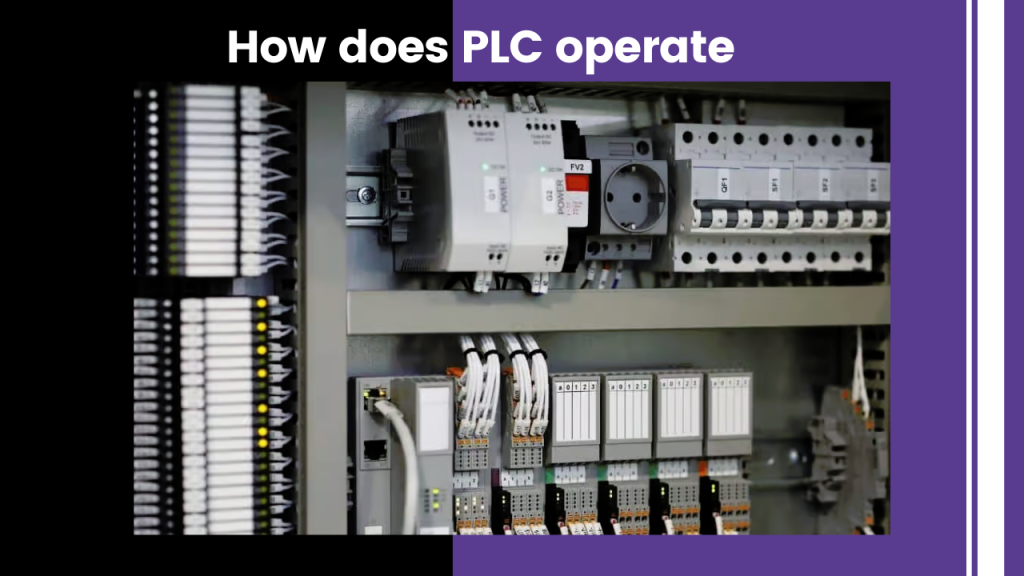How does PLC operate

PLCs (Programmable Logic Controllers) are specialised computer-based control systems needed for industrial automation and production operations. Its goals include performing a variety of control actions, monitoring inputs, and executing outputs in accordance with pre-programmed logic.
- Input Modules: Signals are sent to PLCs from various sensors and industrial process machinery. These devices may include temperature sensors, pressure sensors, limit switches, proximity sensors, and more. The input modules in the PLC must connect with the analog/digital signals from these devices and convert them into a format that the PLC can understand.
- Signal Conditioning: Input modules usually contain circuitry for signal conditioning. This may involve noise filtering, amplification, or analog-to-digital conversion (ADC) for analogue signals. Signal conditioning improves the accuracy and dependability of data collecting from the connected sensors.
- Isolation: Input modules are often used to provide electrical separation between the internal circuitry of the PLC and the field devices. Electrical noise, voltage spikes, and other disturbances that could harm the PLC’s dependability and performance are isolated from it.
- CPU (Central Processing Unit): The CPU is the brain of the PLC. It receives data from the input modules, processes the data using the programme stored in its memory, and then determines the state of the outputs based on the logic in the programme.
- Program Execution: The CPU’s memory is accessed in order to read and execute the control software. The control programme is usually written using ladder logic, functional block diagrams, or other PLC-specific programming languages. The program’s logic specifies how the PLC should respond to different input scenarios and how it should control the output devices.
Click here :- Allen Bradley 1766-L32BXB MicroLogix 1400 PLC
- Program Memory: Th The user-programmed logic that specifies how the PLC should function is stored in programme memory. Typically, this logic is expressed in ladder logic, functional block diagrams, or other PLC-specific programming languages.
- Program Storage: The user programme is kept in non-volatile memory, thus even if the PLC loses power, it doesn’t affect the programme. This makes sure that the control logic is preserved and is available for use after a power outage.
- Programming Languages: The most popular programming languages for PLCs are ladder logic, functional block diagrams (FBD), and structured text (ST). Control engineers and electricians may easily understand ladder logic since it is graphical and mimics representations of electrical relay logic.
- Logic Execution: The logic of the programme is continuously looped via the CPU. It takes the input values, runs them through the logic, and then modifies the outputs to reflect that.
- Scan Cycle Recap: Prior to talking about logic execution, it’s critical to comprehend the scan cycle. The PLC’s primary mechanism of operation is the scan cycle. Read inputs, run logic, and update outputs are the three basic steps. To maintain continuous real-time control over the industrial process, the scan cycle is repeated.
- Output Modules: The PLC’s output modules take signals from the CPU and transform them into signals that may be used to control a variety of actuators and equipment, including lights, motors, valves, solenoids, and motors.
6. Human Machine Interface (HMI): Rockwell Automation PLCs are frequently linked to an HMI, which offers a graphical user interface for operators to view the process and communicate with the PLC. Operators can examine warnings or notifications, visualise the process, and make modifications thanks to the HMI.
- Graphical Interface: The graphical user interface (GUI) that the HMI commonly uses shows information visually through the use of images, icons, and animations. This interface is made to be user-friendly and simple to grasp so that both seasoned operators and individuals with less technical knowledge can utilise it.
- Communication: In the industrial setting, PLCs frequently interact with other systems and devices via communication. This could involve exchanging information with other PLCs connected to the network, distributed control systems (DCS), or supervisory control and data acquisition (SCADA) systems.
- PLC-to-PLC Communication: In some industrial applications, distinct process components are controlled by a number of PLCs. These controllers may coordinate their activities and communicate data thanks to PLC-to-PLC communication. For large-scale automation systems, where various PLCs collaborate to control complicated operations, this communication is crucial.
- Scan Cycle: An full reading of inputs, running of the programme, and updating of outputs is referred to as a “scan cycle.” PLCs may retain real-time control over the industrial process by repeatedly executing this scan cycle at high speeds.
- Read Inputs: The PLC first reads the status of each input device attached to the input modules to begin the scan cycle. These input devices might be analogue (sensors providing continuous variable values like temperature, pressure, etc.) or digital (ON/OFF switches, push buttons). Each input’s status is recorded by the PLC and stored in memory for later processing.
In conclusion, PLCs function as real-time control systems that process inputs, carry out logic in accordance with pre-programmed steps, and provide outputs to control diverse devices in industrial applications. They are dependable, strong, and frequently utilised in automation to increase effectiveness, security, and production across a range of industries.
We are Asteam Techno Solutions Pvt Ltd: the go-to company for industrial automation products. We make a contribution to the circular economy by providing all industrial automation products for businesses and factories and also providing service work for them. We provide automation solutions with reputed brands including Allen Bradley, Mitsubishi, Phoenix Contact, Siemens, Schneider, Moxa, VIPA and more. Currently our staff members are serve a growing number of national and international customers each day.
--------------------------------
Guestbeat.com Notice!
Audience discretion is needed, Read TOS.
Submit Guest Post / Read Latest / Category List
App & Rate-Us / Subscribe Daily Newsletter (FREE)



